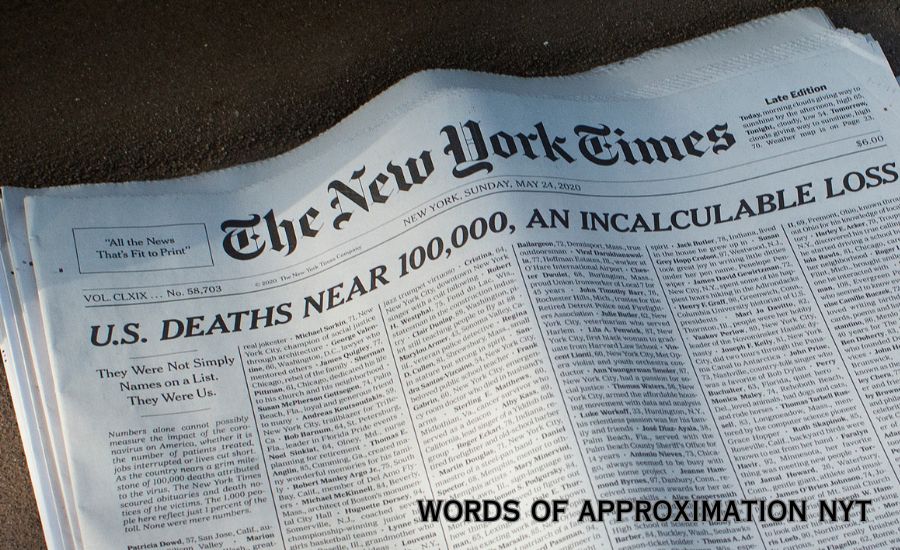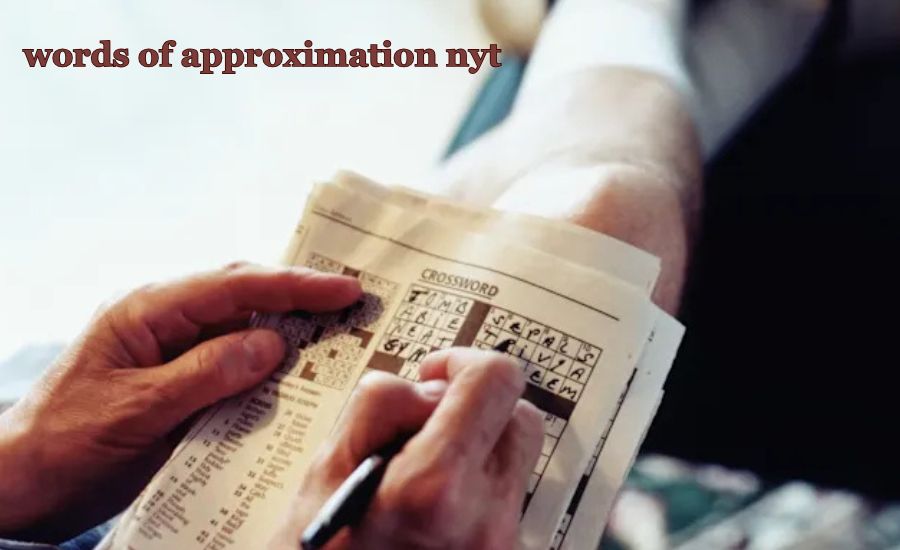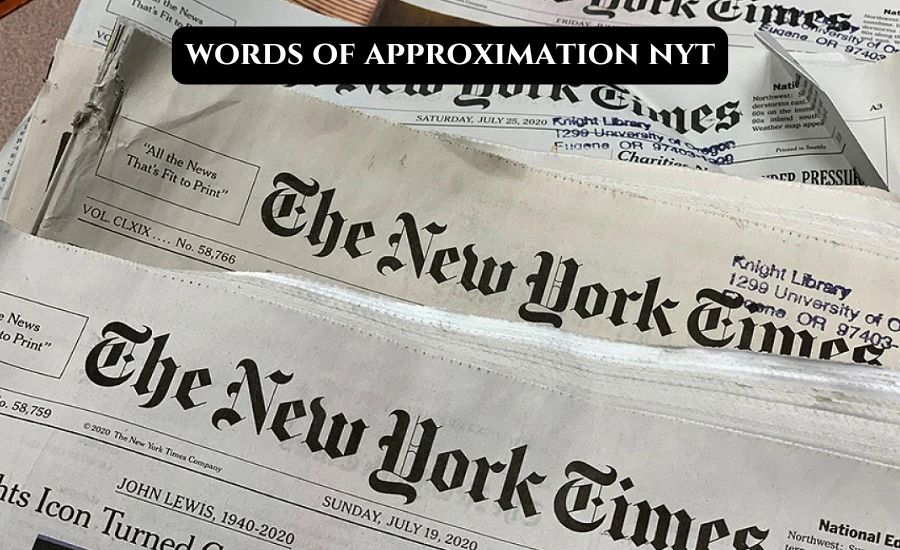Words of Approximation NYT: Unlocking Their Meaning and Powerful Use
Words of approximation NYT are often used when we are not sure about something. These words help us give an idea without being exact. For example, words like “about,” “almost,” or “nearly” are used when we do not know the exact number or fact. The New York Times (NYT) often uses these words in news articles to describe situations where details may change.
Using words of approximation NYT makes writing more flexible. It helps writers share information without making mistakes. Readers also understand that the facts might not be final. Learning these words can help us in everyday life, like when we talk about time, prices, or distances.
What Are Words of Approximation NYT?
Words of approximation NYT are words used to give an idea of something when the exact details are not known. These words help people share information without being too specific. For example, words like “almost,” “around,” and “approximately” are commonly used.
Many writers use words of approximation NYT to make their writing more flexible. It allows them to explain things without giving exact numbers or facts. This is useful when details might change later.
People often use these words in daily life as well. When talking about time, money, or distance, approximation helps to make conversations easier. It prevents mistakes and misunderstandings.
Why Do Writers Use Words of Approximation NYT?
Writers use words of approximation NYT to avoid mistakes in their writing. Sometimes, exact details are not available, so approximation words help provide a general idea. This way, readers get useful information without confusion.
In news articles, these words make the report more reliable. Journalists may not have complete details at first, so they use approximation to keep the article accurate. This helps maintain trust with the audience.
Furthermore, approximation words are useful when facts may change over time. Instead of giving incorrect details, writers prefer to use words that show the information is not final.
Common Examples of Words of Approximation NYT

There are many words of approximation NYT used in writing. Some common ones include “about,” “nearly,” “roughly,” and “more or less.” These words are helpful in different situations.
For example, when someone says “about 10 people came,” it means they are not sure of the exact number. This makes the conversation easier and less strict.
These words are often seen in articles, reports, and everyday speech. They help to make sure the message is clear without being too exact.
How Words of Approximation NYT Help in Daily Conversations
In daily life, people use words of approximation NYT to talk about things in a simple way. These words help when they do not know the exact details but still want to share useful information.
When talking about prices, people might say “around $50” instead of giving an exact number. This makes it easier for others to understand without confusion.
Using approximation words in conversations also helps avoid misunderstandings. It allows people to communicate better without feeling pressured to be exact.
Words of Approximation NYT in News Reports
News reports often include words of approximation NYT to provide details without being too precise. Reporters may not always have complete information, so they use approximation to give the best possible details.
When covering breaking news, reporters may write “nearly 100 people attended” if the exact count is unknown. This keeps the report accurate while waiting for official numbers.
Readers trust news reports that use approximation words because they understand that information can change. It helps to maintain credibility and accuracy.
The Importance of Using Words of Approximation NYT Correctly
Using words of approximation NYT in the right way is important for clear communication. Writers should choose the right words to match the situation and avoid confusion.
These words should be used carefully to make sure the message is still clear. Using too many approximation words can make writing unclear.
When used properly, approximation words help to keep the writing flexible and understandable for everyone.
How to Identify Words of Approximation NYT in Articles

It is easy to find words of approximation NYT in articles if you know what to look for. Words like “almost,” “about,” and “nearly” are common examples.
When reading an article, look for words that suggest an estimate or guess. These words are usually used when the writer is not sure of the exact details.
Identifying these words can help readers understand the message better and know that the information might not be exact.
Tips to Use Words of Approximation NYT in Writing
Using words of approximation NYT in writing can be easy with a few tips. Here are six helpful points to remember:
- Choose the Right Words: Pick approximation words that fit the situation well and provide the correct meaning.
- Avoid Overuse: Do not use too many approximation words in one piece of writing to keep it clear and direct.
- Know Your Audience: Use simpler approximation words when writing for a general audience to avoid confusion.
- Check Context: Make sure the words match the context of your writing to maintain accuracy.
- Practice Regularly: Try using approximation words in daily writing to become more comfortable with them.
- Read More Articles: Reading newspapers and blogs can help you understand how professionals use approximation words correctly.
Practicing with examples can help writers learn how to use these words correctly and improve their writing skills.
Words of Approximation NYT vs. Exact Words: What’s the Difference?
In writing, you can choose to use exact words or words of approximation. Words of approximation NYT help to give readers a general idea instead of exact facts. These words are useful when you don’t know something perfectly but still want to communicate your thoughts.
Exact words are more specific. They are great when you want to give clear and detailed information. For example, if you’re describing the temperature outside, saying “It’s 72°F” is precise. However, using words of approximation NYT, like “around 70°F,” makes it a bit more flexible. Approximation words can keep your writing light and easy to understand.
How Words of Approximation NYT Make Writing More Flexible
Using words of approximation NYT can make your writing more relaxed and flexible. When you use these words, you don’t have to worry about being 100% exact all the time. It lets you express yourself without getting bogged down in the details.
In real life, things aren’t always perfectly clear. For example, if you’re talking about the weather, you might say, “It was nearly sunny all day.” This isn’t exact, but it still gives a good idea. Approximation words like “nearly,” “about,” or “almost” help convey the message without worrying about tiny details.
Mistakes to Avoid When Using Words of Approximation NYT

When using words of approximation NYT, it’s important not to overdo it. If you use too many of these words, your writing can start to sound uncertain or unclear. For instance, saying “I sort of saw her” or “I kinda like it” can make your writing weak.
Instead, focus on finding the right balance. Use approximation words when it’s needed, but don’t rely on them all the time. It’s important to still communicate your main ideas clearly. You can use words of approximation NYT to soften your sentences but make sure your message remains strong.
How Words of Approximation NYT Can Change the Meaning of Sentences
Words of approximation NYT can dramatically change how a sentence sounds. For example, if you say, “It was almost impossible to finish the project,” it gives a sense of struggle. But if you say, “It was impossible to finish the project,” it sounds more certain and final.
The choice of approximation word can also impact the tone of your writing. Words like “about,” “roughly,” or “almost” make your sentences feel less intense and more open. They allow room for flexibility and different interpretations, making your writing feel more conversational.
Learning New Words of Approximation NYT for Better Writing
Learning new words of approximation NYT can improve your writing skills. You can start by looking for words that give an idea without being too exact. Words like “nearly,” “around,” and “roughly” can be useful in different situations.
By practicing these words, you can make your writing sound more natural. You don’t always have to give exact details. For example, instead of saying, “I have 10 cousins,” you could say, “I have about 10 cousins.” This small change makes your writing more flexible.
You can also expand your vocabulary by reading. Notice how authors use words of approximation NYT in books, articles, or stories. By learning from them, you can start using these words in your own writing to sound more fluent.
Fun Ways to Practice Using Words of Approximation NYT
There are fun ways to practice using words of approximation NYT in your writing. One way is by playing games with family or friends. For example, you could describe something without being too exact, and they have to guess what you’re talking about. It’s a fun challenge that helps you practice.
Another fun way is to write short stories using words of approximation NYT. Try describing a scene with as few exact details as possible. This will help you get comfortable with these words and show you how they change the way your sentences sound.
Conclusion
In conclusion, words of approximation NYT are super helpful when you want to make your writing sound more relaxed and natural. They let you share ideas without being too strict about exact details. Whether you’re telling a story or just describing something, these words can help you communicate in a way that’s easy to understand. They also make your writing feel more friendly and less formal.
However, it’s important to use words of approximation NYT wisely. If you use them too much, your writing might sound weak or unclear. It’s all about finding the right balance. So, the next time you write, try using some of these words and see how they change your sentences. With practice, you’ll get better at making your writing more flexible and fun!
Learn More: I-am-quanhulio
FAQs
Q: What are words of approximation NYT?
A: Words of approximation NYT are words used to give an idea without being exact. They help make writing more flexible by indicating estimates or rough ideas, like “about,” “almost,” or “around.”
Q: How do words of approximation NYT improve writing?
A: These words make writing more casual and easier to read. They help avoid exact details, making your sentences feel natural and less stiff while still conveying the main idea.
Q: Can words of approximation change the meaning of a sentence?
A: Yes, they can. Words of approximation can make a sentence sound less certain or softer, changing the overall tone. For example, “about 10 people” feels less exact than “exactly 10 people.”
Q: When should I use words of approximation NYT?
A: Use them when you don’t need exact details, like when talking about numbers, time, or general ideas. They’re perfect for making your writing sound more relaxed.
Q: Are words of approximation NYT always necessary?
A: No, they aren’t always needed. Use them when it’s okay to estimate or be flexible. In situations where accuracy is important, like scientific writing, it’s best to avoid them.
Q: Can using too many words of approximation be a problem?
A: Yes, using too many approximation words can make your writing sound uncertain or weak. It’s important to balance them with precise language when needed.
Q: What are some common words of approximation NYT?
A: Some common words include “about,” “around,” “nearly,” “roughly,” and “almost.” These words help estimate quantities, time, or distance without being too exact.
Q: How can I practice using words of approximation NYT?
A: You can practice by writing short sentences or stories using approximation words. Reading news articles or stories can also help you see how these words are used in real-life writing.





Post Comment